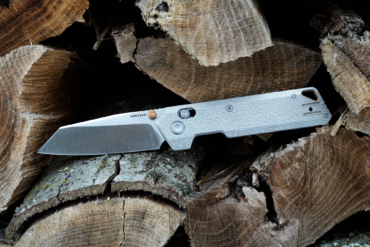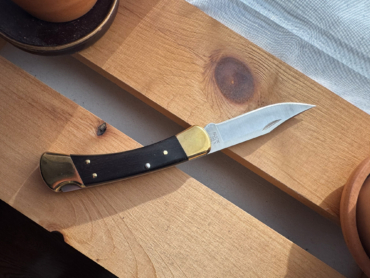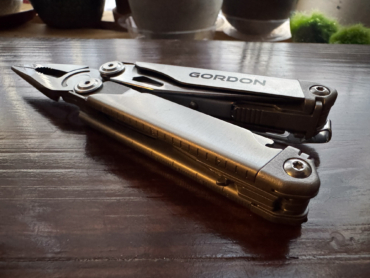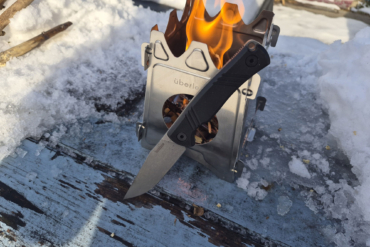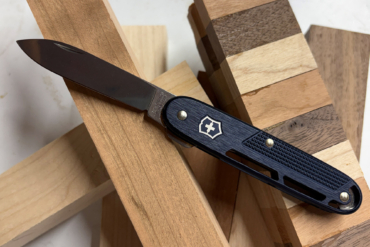Consider steel, size, and intended use to pick the ideal knife for you (or someone else).
The gift of a first knife is special. I remember mine – an Old Timer Stockman purchased from the gift shop at Paul Bunyan’s Cook Shanty. Makers and materials have changed since then, and I’d argue significantly for the better.
But with so many choices now available, shopping for a knife can be hard. This is especially true if you’re trying to pick out something memorable, that “First Knife” for a friend, child, or relative. Fear not! GearJunkie is here to simplify the process because darn it, that’s just what we do.
First up: Unless you’ve already done some research, do not go to your local big box store and randomly select something that comes in a blister pack. Or at least, not without reading our tips on blade steel, measurements, and locking mechanisms below.
In general, you’re going to be better off with a reviewed and recommended model from one of the many Best Of lists that follow.
And maybe the best bit of news is this – to get a first knife that can last for years to come, you don’t need to spend all that much. Here are some questions to consider as you shop:
How will the knife be used?
Close your eyes, and imagine the person you’re shopping for. What kind of tasks do they perform on a daily basis, and how many of these require a cutting tool? If their main opponents are things like carrots, onions, and the occasional cardboard box, then you’ll want to shop for something with a thin, slicing edge.
Generally, these will be knives where the widest part of the spine measures 0.10 inches or less. For industrial work or other heavy-duty users, go with something thicker, up to perhaps 0.14 inches. Anything in between these two figures should provide a good intermediate experience.

This leads to the next question: Fixed blade or folder?
This one is simpler than it sounds. Does the person you’re shopping for spend a lot of time traipsing around the woods? Then a fixed blade from our Best Bushcraft or Best Survival Knives is definitely the way to go. The stainless Morakniv Companion, for example, is a proven, budget-friendly offering that’s as versatile as it is capable.
But for general everyday carry, folding knives are the best bet. With a few exceptions, that’s what we’ll be discussing for the rest of the guide.
First Knife Buying Guide
Consider Materials & Price
Look, this is a first knife. That doesn’t mean it has to be the best knife. In fact, I’d recommend saving your sanity and not trying to purchase something at the peak of the EDC mountain.
The air up there is too stuffy, anyway. In truth, you’re better off seeking out something on the lower end of the middle. Our list of the Best Pocket Knives is chock full of great options, four of which come in under $100.

Still, there’s nothing wrong with shopping around on your own. Just be sure to pay attention to a few of the basics, such as blade steel, handle materials, and the locking mechanism (or lack thereof).
On the steel front, the first thing you’ll want to look for is a metal that’s properly identified. If the description simply reads “stainless steel,” don’t buy it. Likewise, anything with a combination of letters such as “7-8Cr” and “MoV” should generally be avoided. These low-end steels will dull and rust with even the most basic use. “D2” steel is a good place to start, as is something like Nitro-V. For a full rundown, see our explanation of common blade steels.
Handle materials are a bit easier. In the gifting price range, you’ll likely be faced with FRN, G-10, Micarta, or possibly aluminum. Each of these is fine, though I’d generally steer new knife folks away from metal handles. More often than not, those first three will give you a warmer feel and better grip.
Lastly, the lock – just how fancy do you want to be? If the person you’re buying for is reasonably coordinated, then something like a frame or liner lock should serve your turn.

If you want to keep things as easy as possible, a button lock or back lock is the simplest way to go. There are plenty of other variants, but you need to know that most modern locking mechanisms are generally pretty solid.
Also, does the person you’re shopping for live in a major city? If that’s the case, give a thought to the length of the blade. You’ll definitely want something with less than three inches of cutting surface, and steer clear of anything spring-loaded or bearing the phrase “assisted opening.”
Wild Card Considerations
Is the person you’re shopping for left-handed? If so, you’ll need to find a knife with a pocket clip that can be swapped to the opposite side. Look for an extra set of screw holes near the end of the handle, or consult the description to see if a word like “reversible” appears.
This leads to another discussion: Should you buy a knife that rides in the pocket with its tip pointed up or down? For 99% of the population, I’d strongly recommend tip-up. And as to that other 1%, well, you can’t reach everyone.
Tip-up sounds more dangerous, “Oh no, there’s a pointy thing sticking out in my pocket.” But the reverse is actually true.
The blade tip might be facing upward, but it’s held in place by the back seam of your pants pocket. Unless something goes very, very wrong, it’s the best way to keep a folding knife shut.
Tip down, however, presents a host of problems. When you pass the knife into your pocket, your jeans will press against the opening mechanism. This bit of pressure can pop the blade open and cause a nasty gouge when you reach down for your wallet. Ask me how I know.
Is It for a Child?
I’m giving this an entirely separate category because buying a knife for a kid can be tricky. The focus here should be on safety, above all. For this reason, I’d steer youth shoppers toward something simple, like a small fixed blade. The Morakniv Eldris, for example, is a wonderful tool aimed at folks with smaller hands.

If it needs to be a folding knife, then I’d advise you to look for one of two things – a simple lockback (such as the Ladybug or Dragonfly from Spyderco) or a multitool/traditional knife.
Victorinox’s Swiss Army line is a great place to start, and Case makes some decent entry-level blades. “Slipjoint” is a word used to describe these non-locking knives, such as the excellent Real Steel Luna.
Whomever you’re shopping for, be sure that you (and they) keep the following thought in mind: Whether it’s your first knife or their tenth, knives are best considered tools, not self-defense weapons or things to flip around and impress your friends.
Blades are sharp, and they will cut. So be sure to keep the edge pointed at wood, cardboard, foodstuffs, or other similar materials.
And it might not hurt (both literally and figuratively) to watch a knife safety video to help lay a safe foundation.




